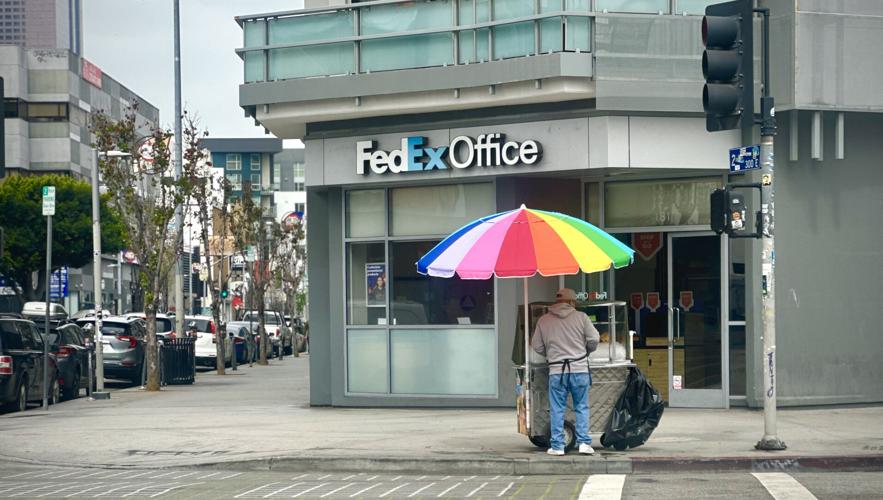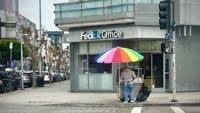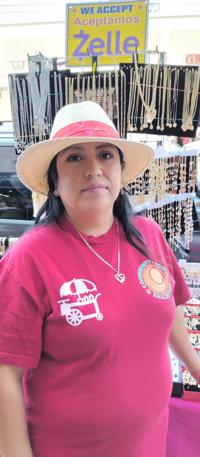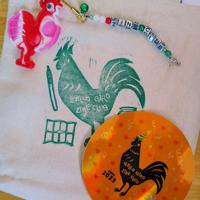
There is approxiately 50,000 street vendors in the City of Los Angeles, with 10,000 selling food. Photo by Brenda Verano
With over 2,000 wholesale businesses and numerous street vendors, the Fashion District is a cultural and economic hub frequented and used by millions of people each year. Known for its eclectic selection and bargain prices, it is one of the many local and open market areas in Los Angeles.
Earlier this month, on April 6, L.A.’s Fashion District was the location of an automobile incident that left at least nine people injured after a minivan drove into a crowd of people.
While still under investigation, video from the scene, much of which was captured by community members, shoppers and vendors, showed the van on the sidewalk just outside of Santee Alley, one of the most populated areas of the Fashion District, where many buyers walk by and vendors sell different items.
Although all victims, which included three kids, were in “fair condition” immediately after the incident, the location of the incident raises questions about the risks and tribulations vendors and on-foot merchants face daily.
Besides the numerous attacks against street vendors and the constant and ongoing criminalization of their activities, there are also other daily risks, many times overlooked, that vendors are constantly and tragically exposed to.
Exposure to extreme weather conditions, heat strokes, inadequate water and sanitation facilities, and being victims of errant automobiles are all real and alarming risks, which can lead to health problems and economic losses for millions of street vendors in the city.
Air pollution, resulting in bad air quality, is also one of the most detrimental challenges for street vendors, especially in the months during and after the 2025 L.A. wildfires.
Unlike some of the attacks, robbery, discrimination or criminalization incidents that they face, these environmental risks are not always reported or do not have an adequate way to be tracked, which experts say makes it hard to know the real circumstances of vending outdoors.
“The everyday kind of battles that vendors go through aren't really highlighted,” Shannon Camacho, senior policy associate of Inclusive Action, a community organization providing resources and grants to vendors and small businesses, told CALÒ News. “Even vendors themselves sometimes, unfortunately, kind of normalize these conditions because they have been in them for so long.”
Inclusive Action was a co-founder of the LA Street Vendor Campaign (LASVC), a citywide effort that resulted in the legalization of street vending in 2018 and a statewide policy that decriminalized street vending throughout California. Today the organization continues to advocate for the equitable implementation of new vending rules in L.A. and making sure, through local organizing and advancing state police, that street vendor permits are allocated locally and statewide.
The Bureau of Street Services estimates that 50,000 microbusinesses are set up on the sidewalks each year. Ten thousand of those street vendors specifically sell street food.
Camacho, who works closely with vendors, said street vendors come to their Boyle Heights offices on a daily basis. It is through these built relationships that Inclusive Action has been hearing of these everyday risks that they face.
“Working outdoors, on L.A. sidewalks on Hollywood Boulevard or Downtown [L.A.] or other overpopulated areas, is not easy,” she said. “It comes with its own unique kind of danger. Many times [vendors] don't know if they're going to get into a car crash or might be victims of theft or be hit by a heat stroke in the summer.”
Claudia Moreno-Santana, 48, sells jewelry and accessories in the Fashion District, very close to where the minivan incident happened last weekend. She said these types of incidents are not uncommon in the open street market. “This instance wasn’t fatal, but I know many that have been. I’ve heard of vendors that have passed away from incidents like these,” she said. “Street vendors are the most impacted working class because we work outdoors. Regardless of what the outside circumstances are, we cannot afford not to work or take the day off, rain or shine.”
Moreno-Santana, originally from Mexico City, is a street vendor leader who, throughout time, has helped organize and mentor other vendors like herself who are located in the Fashion District. She is a member leader with Community Power Collective (CPC), a cross sectoral organizination in L.A., leading efforts on economic justice, community control of land and housing and street vendors rights. She has been organizing for street vendor justice with the organization for more than five years.
“We try to educate vendors about their rights and their safety. We are essential not just to the economy of the city but also to the culture. Sometimes when I see other vendors walking on the side of the road, I ask them to come to the sidewalk for their safety and that of others. That's just one example of how we make sure we are all well and that we continue to persevere,” Moreno-Santana said.

Claudia Moreno-Santana, 48, sells jewelry and accessories in the Fashion District. Photo provided by Claudia Moreno
She works most days of the week, and many times more than eight hours a day. Other than being exposed to automobile accidents that can happen at any time, she told CALÒ News that the heat, rain, strong winds, polluted air and inaccessibility to restrooms are just some of the things vendors like herself deal with on a day-to-day basis. “Rain or shine, we are out here,” she said. “Sometimes it does get to the point where we have to close our businesses for the day because we do not want our things to get wet or be blown away. That's the vulnerability of a street vendor: selling on the sidewalk.”
Summer being around the corner can signify an increase in sales to many street vendors. Still, Moreno-Santana said that is also one of the most physically challenging times for many vendors. “It can get really hot,” she said. “Especially in places like [the Fashion District] where it’s very populated and visited.”
Camacho said the other vendors they work with have also had problems with the heat and heat strokes, something she said can be severe when it comes to older vendors. “The majority of the folks that we’ve worked with over the years are older. Many of them are over 50. These things can be even more challenging to this age group,” she said.
As of now, there is little to no data on any informative instances of street vendors dealing with everyday things like climate, weather or the overall environment. The Los Angeles County Climate Vulnerability Web Map, published in 2023, includes approximately 90 layers across boundaries, climate hazards, physical infrastructure, social sensitivity indicators and adaptive capacity.
According to the map, places where street vendors heavily populate L.A., like the El Salvador Corridor, MacArthur Park or downtown L.A., were all in “high” areas of social sensitivity. The social sensitivity index shows that these areas are particularly vulnerable to health emergencies and other hazards, like climate change or heat waves.
Moreno-Santana said that one of the other environmental and social challenges that vendors go through is the inaccessibility of restrooms. "Fortunately enough, we have places here that are rented out for other vendors, or there are other places that let vendors use their restrooms too, but we also have vendors that are walking around and selling their stuff, and in those times restrooms are harder to find and locate,” she said.
Holding urine for an extended period can lead to several complications, including urinary tract infections (UTIs), bladder dysfunction and in rare cases, even bladder rupture. For women, these risks can be greater, according to the National Institute of Health.
For many vendors, setting up their food and fruit stands under rainbow-colored umbrellas also means a possible threat to their safety, including being verbally and physically attacked.
Senate Bill 946, which is also known as the Safe Sidewalk Vending Act, was signed in 2018 by former Governor Jerry Brown, but Camacho said that despite L.A. decriminalizing street vending in L.A. in 2016 and the legalization of it in California in 2018, many vendors still face various risks.
“Despite the laws changing, it is not always easy for vendors,” she said.
Cassidy Bennett, a staff attorney with Public Counsel's Community Development Project, said that while different cities and counties in L.A. have put forward efforts to streamline the process of obtaining vendor permits, many street vendors operate without permits due to legal and monetary roadblocks.
“SB-946 enacted a blanket of legalization but under that umbrella, there is so much more to unpack,” Bennett told CALÒ News.
As previously reported by CALÒ News, in some cities, including Huntington Park, the over-regulating of street vending has made it impossible for many low-income peopleto sell their products.
Huntington Park ordinances for street vendors include obtaining a Sidewalk Vending Permit and a City of Huntington Park business license that must be renewed annually. To complete a Sidewalk Vending Permit, food vendors need to turn in a total of six documents, including a County of Los Angeles Health Department Cart Approval, a Business Tax Registration Certificate, and a California Department of Tax and Fee Administration (seller’s permit).
In addition to the documents, street vendors must also agree to turn in live-scan fingerprints of the business owner and each vendor employee identified in the permit application; vending operations information, including days and hours of operation map of the scheduled traveled route; trash receptacle information; and proof of a $2 million liability (minimum) insurance policy, among other documents.
Public Counsel, which helps vendors with things such as appealing or reducing the costs of tickets they might get from the city or law enforcement and policy-related work, has been educating street vendors on their rights and safety. “In recent times, it has not gotten easier,” Bennett said.
Although there isn't much information about attacks on street vendors in L.A. in 2024, in 2023 Crosstown, a nonprofit publication, compiled public data that showed that in July 2023, there were 43 reports of street vendors being victims of a crime—the highest monthly tally since 2010 and more than double the June 2023 figures.
“We take care of each other,” Moreno-Santana said when talking about the vendor community that she has built. “When we need to go to the restroom, we look after each other's stands. We look out for one another because, at the end of the day, we are all a community. If one of us has issues, we make sure we are there for one another.” Camacho also said that vendors take good care of each other and rely on each other daily when it comes to safety and security. Vendor networks and chats are common among the different vendor zones, yet the fear and stress of being a vendor can be hard on their emotional and mental health.
At Inclusive Action and CPC, many vendors have reached out to talk about the fears of encountering United States Immigration and Customs Enforcement (ICE) or being detained in the streets. Despite L.A. being declared an official sanctuary city last November, meaning that no city staff or resources could be used to collaborate with federal immigration authorities such as ICE or United States Citizenship and Immigration Services (USCIS) without a judicial warrant, fear and worry are still very present in the lives of these vendors.
“Many of the vendors in Los Angeles are undocumented and being in constant worry or stress can have a huge impact on their health,” Camacho said. “The Trump administration coming into power has a huge impact on folks being more afraid to sell. The reality is that many have stopped vending as much or others have had to relocate to locations that feel safer.”

Claudia Moreno's setup in February 2025. Photo provided by Claudia Moreno
Moreno-Santana said that vending zones like the Fashion District have felt different since the recent ICE raids that have been seen in cities like L.A., not only scaring some vendors away but also scaring some of the community and buyers from heavily populated areas like those of the district. “It feels different these days,” Moreno-Santana said. “La clientela ha bajado.”
For vendors' rights organizations like Inclusive Action, CPC and Public Counsel, supporting vendors is vital, today more than ever.
“It’s important for the community to continue supporting and looking out for street vendors, but it’s also equally important to build legislative avenues of change and betterment for them. Our local governments, the city and the county, need to create and allocate more resources for vendors, whether that's like health insurance or whether there's a way to compensate folks or create policies to mitigate some of the health risks.”
Today, they, along with other organizations and coalitions, have a close relationship with city council districts, especially where there are a lot of vendors.
When it comes to automobile incidents or other work-related incidents like that which happened in the Fashion District, Bennett said that documentation and conferring with an attorney as soon as possible are crucial to making sure street vendors receive the help and support they need.
“Documentation is crucial… whether it is taking pictures of their setup, of the accident or obtaining photos of the scene or incident,” she said. “The sooner they can speak to a lawyer or attorney, the better.”
Last month, Senator Maria Elena Durazo (D-Los Angeles) introduced SB 635, a bill that hopes to set protections for undocumented street vendors in California.
The bill, co-sponsored by several immigrant advocate groups, including Inclusive Action for the City, the Coalition for Humane Immigrant Rights of Los Angeles, Community Power Collective, and Public Counsel, would prevent local governments from sharing street vendor data with ICE agents.
“It can be difficult to show up every day if there are fears, especially if those fears are related to their work,” she said.
If passed, the bill would also prohibit sidewalk vending permitting programs throughout the state from even asking about a potential vendor's immigration status.
For years, vendor members in CPC have been involved in the campaigns for SB 972. Their organizing efforts in Hollywood have also led to a successful lawsuit that helped dismantle L.A.'s no-vending zones.
CPC told CALO News that as they continue to work with the LASVC to advocate for new and improved legislation that supports street vendors like SB 635, they are also organizing with vendors to help establish special vending districts - designated areas where vendors collaborate with each other to create community-based agreements that foster collective safety, economic development and a thriving pedestrian experience.
“We street vendors give so much to California and L.A., a tourist destination. When people come to L.A., they feel at home, and part of that is because of us,” Moreno-Santana said. “We have to keep fighting for ourselves and those who come after us.”















(0) comments
Welcome to the discussion.
Log In
Keep it Clean. Please avoid obscene, vulgar, lewd, racist or sexually-oriented language.
PLEASE TURN OFF YOUR CAPS LOCK.
Don't Threaten. Threats of harming another person will not be tolerated.
Be Truthful. Don't knowingly lie about anyone or anything.
Be Nice. No racism, sexism or any sort of -ism that is degrading to another person.
Be Proactive. Use the 'Report' link on each comment to let us know of abusive posts.
Share with Us. We'd love to hear eyewitness accounts, the history behind an article.